WCBG Construction Standards for Cedar Canvas Canoes
One of the conditions of membership in the Wooden Canoe Builders' Guild is agreement to a set of construction standards set down by the Guild. This ensures that the canoes built by Guild members meet or exceed these standards and are therefore strong, durable and seaworthy craft. Thus, clients may expect that, regardless of the price range or degree of finishing detail, all canoes built by Guild members meet or exceed the standards necessary to produce a strong and durable canoe.
The following are the construction standards adopted by the Guild for cedar canvas canoes 15' and longer and comments on their importance in the construction of a canoe. In each case, these represent minimum standards which a builder may exceed at his/her discretion. These standards are also published in our brochure 'A Buyers Guide to Cedar Canvas Canoes'.
-
Mold / Form
The mold/form on which canoes are built shall be true and fair so that the resulting canoe hull is symmetrical about the centre line, has vertical stems and is not hogged (lower in the middle than the ends when inverted).
* This is important because it ensure that the hull will be true and straight without twists or a hogged bottom. A badly twisted or hogged hull is very sluggish, responds and handles poorly and is not fun to paddle. -
Inwales
Inwales shall have cross section dimensions of at least 3/4"x3/4"before shaping.
* Experience has shown that inwales must be of at least these dimensions to perform their important roles of maintaining hull shape and providing attachments for the thwarts and seats. -
Stems
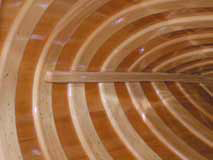 Stems shall be notched to engage at least three full ribs.
Stems shall be notched to engage at least three full ribs.
* The stems of a canoe provide shape and structural integrity to the ends of the canoe. Notching the stems to accept at least three full ribs ensures that the ends of the canoe are securely connected to the centre portion of the hull. Stems that are too short to engage at least three full ribs or which are not notched and simply lie on top of the ribs do not provide sufficient structural strength to the ends of the canoe.
-
Ribs
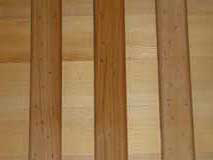 All full ribs shall have a minimum thickness of 5/16". The maximum edge to edge spacing of ribs in the bottom of the hull shall be 2".
All full ribs shall have a minimum thickness of 5/16". The maximum edge to edge spacing of ribs in the bottom of the hull shall be 2".
* - Experience has shown that a rib thickness of at least 5/16" is required to resist breakage from impacts and deformation under a concentrated load such as that created by a heavy solo canoeist. Limiting rib spacing to 2" ensures that the planking is adequately supported by the ribs.
-
Fairing
The outer surface of all ribs shall be faired before planking.
The outer surface of the planked hull shall be faired and treated to enhance longevity before canvasing.
* Fairing is the procedure (usually done using course sand paper) which creates a smoothly curving surface on the outer faces of the ribs and the outside surface of the planks. Fairing removes minor irregularities and is essential to produce a smooth hull. The outer surface of the planking is treated to reduce the absorption of water. Treatment may be with oil or varnish. -
Planking
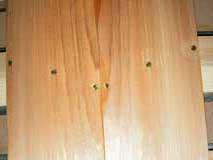 Depressions in the faired hull which would show as depressions in the canvas (eg. Hammer blossoms, knot holes) shall be avoided. Hammer blossoms should be raised with water prior to hull fairing.
Depressions in the faired hull which would show as depressions in the canvas (eg. Hammer blossoms, knot holes) shall be avoided. Hammer blossoms should be raised with water prior to hull fairing.
The space between adjacent rows of planking shall not exceed 1/16".
Each plank shall be fastened to each rib with at least three tacks for a 3" wide plank and four tacks for a 4" wide plank.
Planks shall have a minimum thickness of 5/32".
Tacks shall be of sufficient length, with respect to plank and rib thickness, that a full, strong clinch is achieved.
*Correcting depressions in the hull before canvasing ensures that the canoe will have a smoothly finished appearance. A narrow gap between rows of planking helps to keep sand and other foreign material from getting between the planking and the canvas.
The number of tacks specified for planks of various widths are considered to be the minimum necessary for a strong plank/hull connection.
Staggering the butt joints between adjacent rows of planking provides for a strong hull by preventing the creation of weak spots in the planking.
For canoes of 15 feet and longer a plank thickness of 5/32" is considered to be the minimum required to produce a robust hull. Thinner planking may lack the stiffness to provide the desired hull strength.
The tacks used to secure the planking must be chosen in light of the thickness of the planks and ribs to be used in the canoe to ensure that the clinch achieved is strong and secure. -
Decks
Decks shall have a minimum thickness of 3/4".
Decks shall be fastened to the inner gunwale with a minimum of three screws per side.
* Decks hold the ends of the canoe together and are subject to a lot of stress during use and when the canoe is being transported - especially if a deck ring is used to tie the canoe onto a vehicle. A minimum thickness of 3/4" and fastening with six screws ensures that the decks will not pull out during normal use. -
Covering
-
Cotton Canvas
Canvas shall be fastened at each rib along the shear.
Canvas shall be treated with a preservative which is applied directly to the canvas, at least to the areas under the outwales and the keel or which is contained in the filler.
A suitable filler shall be applied to the canvas.
A minimum of three coats of paint shall be applied to the filled canvas.
* Because the canvas is tightly stretched over the hull, fastening it with two fasteners at each rib ensures that it is well secured and will not pull free during subsequent construction steps and eventual use of the canoe.
A preservative is put on the canvas under the keel and outwale to retard rotting in these areas that typically trap moisture.
The filler applied to the fabric fills the weave of the material and provides a waterproof and hard, solid base for the top coats of paint.
Three coats of a high quality marine yacht enamel are considered the minimum necessary to produce an attractive durable surface. -
Dacron
Dacron fabric is an acceptable substitute for cotton canvas and shall be used in accordance with accepted good practices.
*Traditional cotton duck canvas and synthetic polyester Dacron are the only approved coverings for Guild canoes based on their track record.
-
-
Bedding Compound
Bedding compound, filler or double sided tape shall be used as a sealant when closing the ends of the canvas.
Bedding compound shall be used as a sealant under stem bands and keels.
* Bedding compound is a sealant used between the canvas layers at the ends of the canoe and under the stem bands to prevent water penetration into the underlying wood and/or the interior of the canoe. -
Fasteners
All fasteners shall be made of brass, copper, bronze, silicon bronze or stainless steel.
* These materials are generally considered to be corrosion proof. Plain steel fasteners will eventually rust and not only loose strength but will promote rot in the wood in which they are embedded. -
Outwales
Outwales shall be screwed to the inwales at least every third rib.
The projecting lip of outwales shall be a minimum of 3/16" thick.
Outwales have a rabbet on their back to form a lip that projects over the top of the planking and canvas. The minimum depth for this lip ensures that it is not too fragile and liable to be damaged. Fastening the outwales to the inwales at least at every 3rd rib ensures that these two important members act as one in providing lateral strength and retaining the shape of the canoe. -
Paint
A minimum of three coats of finish paint shall be applied to the filled canvas of every canoe.
The paint used shall be intended for marine use.
* Three coats of paint is the minimum that will reliably provide even colouration and texture and durable protection to the fabric underneath. The paint used must be suitable for both the surface to which it is applied and the conditions under which it will be used. For cedar canvas canoes, these requirements are best met by a marine enamel. -
Varnish
A minimum of three coats of varnish shall be applied to all hidden surfaces-ie. the undersides of decks, seats, thwarts, yokes and deck thwarts and the backs of inwales and outwales.
A minimum of four coats of varnish shall be applied to all exposed wood work. The varnish used shall be intended for marine applications (i.e., spar varnish).
* Varnish is the only thing protecting the exposed wood on a canoe from the damaging effects of the sun and water. Four coats of a varnish designed for such conditions is the least required to perform this function on surfaces exposed to the sun. Varnishing hidden surfaces ensures that they will not absorb moisture. -
Thwarts
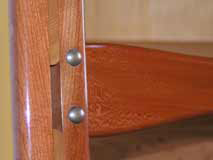 Centre thwarts and yokes shall be fastened to the inwales by two bolts at each end.
Centre thwarts and yokes shall be fastened to the inwales by two bolts at each end.
* The use of two bolts at each end ensures that the centre thwart or carrying yoke performs its function of supporting the gunwales and that it will not twist when used to carry the canoe overhead.
-
Seat Frames
The joints in seat frames shall be of dowelled, mortise and tenon or biscuit construction.
Seat frame joints shall be glued using epoxy, polyurethane or other waterproof glue.
* The seats in a canoe are subjected to a lot of stress and flexing and must have joints that are well made and held together with waterproof glue if they are to last. Joints that are simply screwed together will not be durable over the long term. -
Stem Bands
 Stem bands shall be installed on every canoe.
Stem bands shall be installed on every canoe.
* Metal stem bands provide protection for the ends of the canoe and give it a finished appearance.
-
Keels
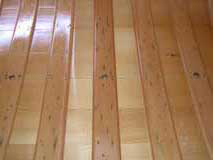 The underside of keels shall be coated (eg. painted, varnished) prior to installation.
The underside of keels shall be coated (eg. painted, varnished) prior to installation.
Keels shall be bedded, full length, with bedding compound or other sealant.
Keel screws shall be fitted with cup washers and shall be a maximum of 10" apart.
*Sealing the underside of the keel with paint or varnish prior to installation helps to keep water from penetrating the wood and thus reducing its life.
The keel is sealed with a bedding compound to ensure a water tight seal around the screws that fasten it to the hull.
Cup washers on the keel screws provide a neat finished appearance while enabling the keel to be securely fastened without damage to the ribs. Limiting the distance between keel screws to 10" ensures that the keel and hull will support each other and move together as the canoe flexes.
_________________________________________________________________________
Definitions
Repair / Reconstruction
The repair, replacement or refurbishment of certain parts of a canoe in order to return them to the desired level of function, condition and/or appearance. Such work may or may not return these parts to their original condition or appearance and may or may not utilize wood types and other materials which are the same as those of the original parts. It will also not necessarily address all parts of the canoe which are in a broken or deteriorated condition.Historical Restoration
The repair, replacement or refurbishment of all applicable parts of a canoe as required to return the whole canoe to its original function and condition and, to the extent possible, to its original appearance. Such work will employ the same wood types and other materials as those originally used for each part and will result in parts of the same shape as the original parts. It is a specific goal of such work to be faithful to the canoe as originally built.
you are at the bottom of the 'Construction Standards' page
